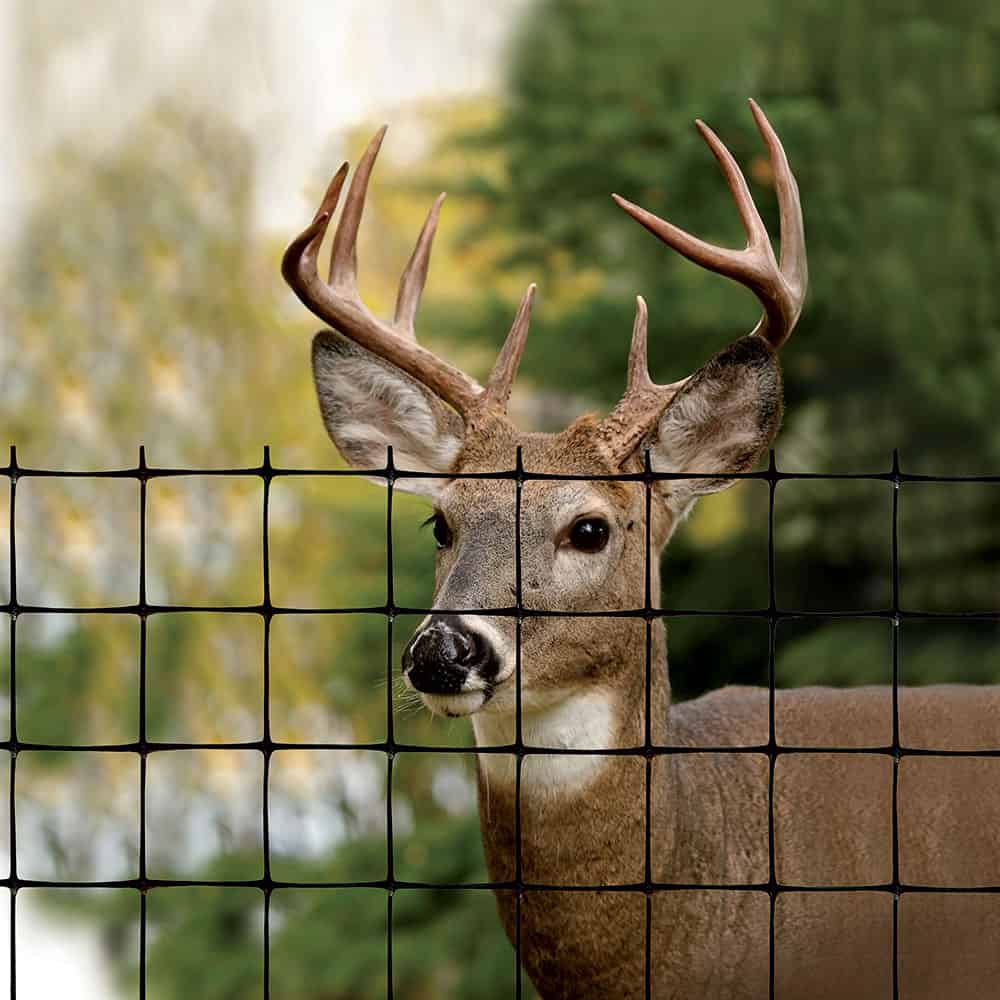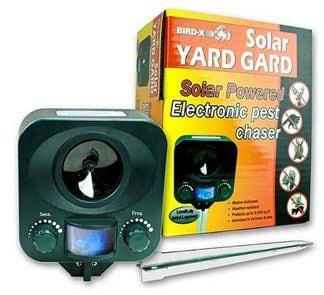
Yes, you can keep deer from eating plants in your landscape. Deer and other wildlife can be fun to watch on your property. But it’s not much fun when deer eat the prized plants in your yard and vegetable garden.
When deer treat your carefully cultivated landscape like it’s a salad bar, it’s time act. To keep deer from eating plants, you need to do something–and fast.
A new generation of deer and wildlife control products is now available that keep deer and other critters away. These products are very effective, and they don’t contain harmful chemicals. From predator scents to low-visibility deer fencing, here are some of the best ways to keep hungry deer from lunching in your garden.
Plus, choosing deer-resistant plants is a great way to reduce browsing by hungry deer. In areas with large populations of deer, using more than one control method will give you the best results.
Use the scent of a predator to repel deer
A great way to keep deer from eating your landscape plants is by tricking deer into thinking that a predator is nearby. Each Summit Deer BanTM repellent capsule contains predator urine that triggers a deer’s animal flight response.
Deer Ban uses a unique gel-tablet application to provide 100% effective, year-round protection from wildlife damage. Just set out the capsules on the ground every five to ten feet around the plants you want to protect. Then water the capsules to release the active ingredient for up to 90 days of protection.
When activated by water, the polymer gel in the capsule releases the scent of predator urine, which keeps deer away. Deer Ban is odorless to humans, and your hands never touch the active ingredient. There’s no messy spraying, and no mixing or measuring.
Many deer repellents wash away and lose their effectiveness after a rain. Not so with Summit Deer Ban. Water actually enhances the effectiveness of Deer Ban because the polymer gel needs to absorb water to activate the odor of the active ingredient. This biodegradable product will continue to be reactivated by rain or watering for up to three months.
Summit Deer Ban is available in packages of 20, 50 and 150 capsules at fine hardware stores, garden centers and online at www.SummitResponsibleSolutions.com and Amazon.
Keep deer from eating plants with a high-strength fence

Tenax fencing features thick, rounded tensile strands that resist stretching and sagging. The material is UV treated so it keeps its color. Tenax deer fencing has a breaking load of 650 pounds and a life expectancy of 10 to 15 years. Perhaps best of all, this fencing is almost invisible from a distance, so it does not block views or create a visual eyesore. A 100-foot-long roll of 7.5-foot-tall plastic mesh fencing sells for about $150 in hardware stores and from online retailers. (8-foot-tall fencing is also available.) For more information about Tenax products, visit www.tenaxus.com/en/ or Amazon.
Solar-powered, motion-activated pest control
Here’s a high-tech way to keep deer and other pest animals out of your yard without using poison or traps. The Solar Yard Gard is a solar-powered ultrasonic pest control device that uses sound waves to keep deer, squirrels, raccoons, rodents, skunks and other animals away from your valuable landscape plants. Humans can’t hear the high-frequency sound emitted by the Solar Yard Gard, but animals hear it and keep away.
Just set up the device in a sunny area. The ultrasonic waves are activated when the motion detector senses an animal. When pest animals activate the Solar Yard Gard, the ultrasonic waves irritate and annoy them so they seek calmer, untreated areas. One device will protect up to 3,000 square feet of landscape. Simply use additional units for larger areas. Not only does the safe, easy-to-use Solar Yard Gard protect plants, but it helps prevent the spread of ticks that can carry Lyme disease. The Solar Yard Gard sells for about $50. Check Price and Availability on Amazon online
Deer-Resistant Plants
Choosing deer-resistant plants for your ornamental gardens is one sure way to reduce browsing by hungry deer. It may be impossible to make your landscape completely deer proof. But selecting plants that deer simply do not like to eat is a good place to start. According to Ruth Rogers Clausen, author of 50 Beautiful Deer-Resistant Plants, there are many beautiful landscape plants that deer do not like to eat because of their aromatic or fuzzy leaves, rough textures or unpalatable taste. Lavender Grosso is a perfect example of an aromatic plant that deer don’t like.
Butterfly Bush (Buddleia species) is a beautiful flowering shrub that attracts bees and butterflies with its prolific flowers. Deer don’t like it at all. Russian Sage is another flowering perennial that looks great in a garden setting that deer will avoid. Even peonies, which create stunning beauty with their large flowers, are seldom browsed by deer.

Junipers repel deer because these evergreen shrubs have volatile oils in their needles. Boxwoods are prized for their consistent evergreen foliage, but deer don’t care for the scent and leave it alone. Experts are unsure why deer don’t like spirea bushes, but these cold-hardy flowering shrubs are a great choice in areas with populations of hungry deer. A Rugosa Shrub Rose Bush is also deer resistant.
There are many smaller flowering perennials that are also shunned by deer. The bright red flowers of Furman’s Red Texas Sage look great in a garden—especially since deer are not interested. The strong fragrance of Ava’s Humingbird Mint keeps browsing deer away. Deer are also likely to avoid the bright yellow flowers of Moonshine Yarrow, the fuzzy Lamb’s Ear leaves and the lavender flowers of Raydon’s Favorite Aromatic Aster. All of these perennials are available from www.HighCountryGardens.com.
Click here for more info about deer resistant plants.
Are you growing vegetables in your garden this season?
Read How to Start a Victory Garden 2.0.
You may also enjoy these posts:
How to Make Dandelion Pesto and Six Lessons I Learned from Garden Failure
Home Garden and Homestead earns a small commission from qualifying purchases on Amazon.com and other partner sites when you click on a link and buy a recommend product. Thank you for supporting our website!





A simpler and cheaper solution is one a friend of mine in middle Tennessee uses in his garden. Unwind the tape from old videocassetes and stake them at two levels around your garden: one at two feet and one at four feet above the ground, the lower one for fawns and the higher one for adults. The shimmering effect from the tape spooks them and they avoid it like the plague, even at night.
Thanks so much for this! Some parts of this are still a mystery to me, and it’s good to have a guide to go back to.
I’m new to this and really need to set up my home. Looks like I’ll be grabbing this info. Thank you!
Irish Spring soap works very well, too, and is used in our Apple orchards here locally. Just hang a bar of soap every 20 to 30 feet and all is good.
It’s essential to keep deer from eating your landscaping plants, and I am thankful you’ve mentioned here how we can do it. I hope you’ll continue to publish content like this.